Natural Weed Control – Non-Toxic Weed Control Options
This post may contain affiliate links. Read my full disclosure here.
Natural weed control has become a hot topic in recent years as more people are realizing that chemical weed poisons can harm more than weeds. (See “15 Health Problems Linked to Monsanto’s Roundup“.) Sometimes you want a natural weed killer, sometimes organic weed control is enough.
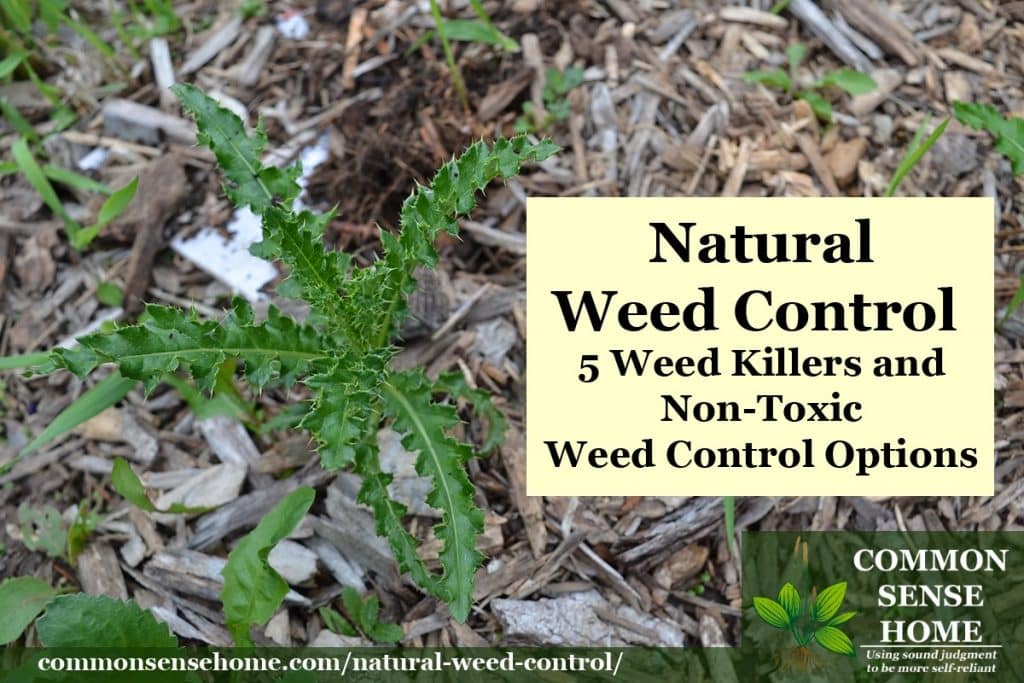
Don’t hate the weeds! Many weeds are edible and/or medicinal, or have other uses such as natural dye or cordage. They can also be used to diagnose soil health, as many weeds thrive in disturbed and damaged soils. They are part of nature’s repair crew.
I use non-toxic weed control so weeds don’t take over the walkways and garden areas. With a little observation and patience and a few simple tools, you can kill weeds naturally without poisons. (“Killing naturally” sounds like an oxymoron, but death and life are part of the natural cycle.)
You can virtually eliminate quackgrass, crabgrass and other problem weeds, and enjoy a tidy yard and lush garden without hours and hours of pulling and tilling.
Natural Weed Control Option #1 – Mulch
Straw Mulch
Oh mulch, how do I love thee! Straw or old hay are my favorite for use in the main garden, as they are less pokey on bare feet.
In permanent garden paths, I lay down cardboard and cover with straw. Within the beds themselves, I lay down a couple layers of damp newspaper and cover with straw.
Why damp newspaper? We get a lot of wind, so using damp paper keeps it from blowing away while we put the straw down. It also speeds up the creation of the happy microclimate under the straw where the soil is cool, moist and protected from scorching summer heat.
Living Mulch for Weed Control
Where I don’t use straw mulch, I use living mulch. You can purchase a number of different plants/seeds to use as groundcover, such as buckwheat, clover, oats, or legumes.
Another option is to work with “volunteer groundcover” AKA weeds. It might sound a little crazy to fight weeds with weeds, but as you work with them you’ll find some weeds are much better behaved than others.
As a double bonus, a number of these groundcover friendly weeds are also tasty.
Some of my favorite weeds to use as groundcover are purslane, lambsquarters and clover. Purslane grounds low to the ground, as does white clover, so they don’t get in the way much at all once plants are established. Lambsquarters gets taller, so I use that near tall crops, like corn or sunflowers.
Last season I let lambsquarters and purslane spread in my corn patch once the corn was established. It was the first year my corn didn’t get knocked over at all during our late summer wind storms.
Could I have used another crop (like beans or squash, “Three Sisters” style)? Yes, I could, but the weeds were free, planted themselves, and I didn’t feel bad walking all over them when it came time to harvest the corn.
I think the Three Sisters arrangement works best with shell beans, winter squash and flint corn, which are all harvested together at the end of the season.
I have had good results planting hills of squash around the edges of the sweet corn patch and letting the vines trail in. This deters raccoons, and keeps the ground open enough that I can still get in to harvest the corn.
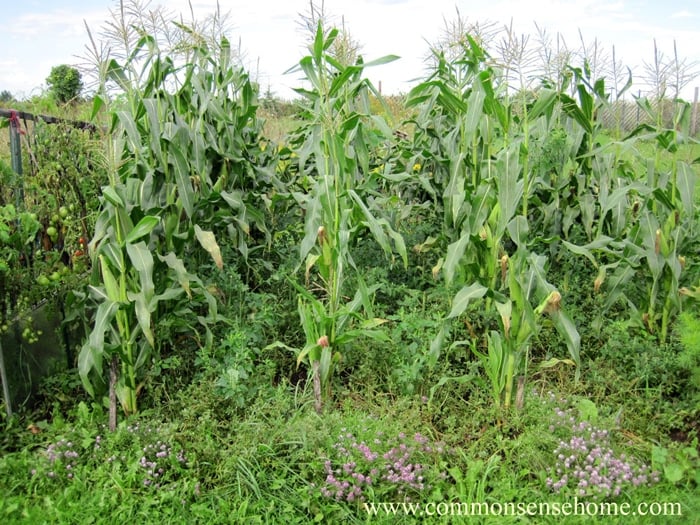
Wood Mulch
Around permanent plantings like trees and shrubs, wood mulch is my mulch of choice, because it takes longer to break down.
I don’t recommend landscape fabric under your mulch. Eventually, grass will break through, and it’ll be harder to remove because it’s caught in the fabric. Cardboard, old paper feed sacks or thick layers or newspaper are my preferred options – or more mulch.
Don’t let the mulch touch the trunk of the tree, or it may cause rot or fungus. Leave a few inches of space to give the tree room to breathe. Think “doughnut”, not “volcano”.
Recently chipped tree tops are particularly good for boosting populations of helpful mycorrhizal fungi under trees. See “Mycorrhizal Planet” for more information on beneficial fungi and how they improve plant health.
Natural Weed Control Option #2 – Homemade Vinegar Weed Killer Spray
A spray bottle filled with white vinegar is simple and cheap. Spritz the vinegar on problem weeds on a bright sunny day. It will damage their protective outer layer and basically allow them to cook in their own juices. (Mean, but functional.)
Want to make your vinegar weed killer spray even more effective? Add an ounce of dish soap per gallon of vinegar. Still not enough? Try adding a quarter cup of salt.
How well does homemade vinegar weed killer work? Results are mixed.
Would you like to save this?
On young broadleaf weeds like dandelion or oxalis, plain vinegar or the vinegar mixes are pretty effective.
On older, more established plants with deep tap roots or quackgrass with long runners, odds are the plant will regrow from the roots. Repeated application will likely be needed.
This spray is also non-specific – you can damage your garden seedlings right along with the weeds. Vinegar and salt may also discolor pavers or walkways.
Heavy use of vinegar may lower soil pH, making the soil more acidic. (Good in the blueberry patch, not so great in other spots.) Use thoughtfully.
Natural Weed Control Option #3 – Boiling Water as a Natural Weed Killer
I put my canning water to use a second time getting rid of the weeds that pop up in the gravel walkway by our front door. Just pour the boiling water straight on the weeds to quick cook them, making sure not to splash yourself.
This is a safer option for any surface you are worried that vinegar may damage. Pretty effective against a range of weed sizes, although like vinegar, larger weeds may require multiple applications.
Natural Weed Control #4 – Get Rid of Crabgrass with Calcium
Weeds are not evil or just here to be a pain in the butt – they serve a purpose. Know your weeds and you will know your soil.
In the book, “Weeds, Control Without Poisons“, Charles Walters provides organic control suggestions for dozens and dozens of weeds. Crabgrass and quackgrass are some of the most troublesome lawn and garden weeds, so I wanted to pay special attention to each of them.
Crabgrass, Digitaria sanguialis, is an annual weed that reproduces by stem rooting and seeds. It is course and clumpy and generally unattractive in lawns.
Mr. Walters says that crabgrass overgrowth indicates that the soil is low in calcium. Specifically, they are soils that “cannot support decay starting with actinomycetes molds”.
With application of calcium lime and sulfur or gypsum, crabgrass is reduced in volume. It effectively rots away over time. A soil test will help you determine how much calcium is needed for your soil.
Quackgrass, Agropyron repens, is a perennial grass that spreads by creeping rhizomes and seeds. The rhizomes are the really trouble makers here, as they can spread for yards through the soil, and a full plant can regrow from any little bit left behind.
Quackgrass is a little trickier to ditch than crabgrass. Mr. Walters sites copper, manganese, soft rock phosphate, vitamin B-12, calcium, molasses, soil aeration and use of sulfates as possible treatments to eliminate this weed. Again, soil testing may help you target the right doses to help you get faster results.
Natural Weed Control #5 – Put Your Weeds to Use!
Ralph Waldo Emerson said, “What is a weed? A plant whose virtues have not yet been discovered.”
Many of the plants we call “weeds” were purposefully transported by settlers around the globe because they were so useful. They need to be “rediscovered”.
The Weekly Weeder series has identification and use information for over 40 common weeds. The book, “The Wild Wisdom of Weeds”, “Backyard Medicine” and my other favorite weed books give wonderful tips and recipes for many more wild plants.
Even my teenage boys have been won over by the taste of mock spinach pie made with lambsquarters, and ask for it in season.
My eldest is always game to taste test anything I give him an “okay” on, and my youngest is always asking about which plants are used as habitat for which critters.
When we work in the garden and yard, they ask which weeds to keep and which ones to remove. I love to identify a new useful “weed” in the yard or garden, like when I discovered a patch of self heal at the base of the swales.
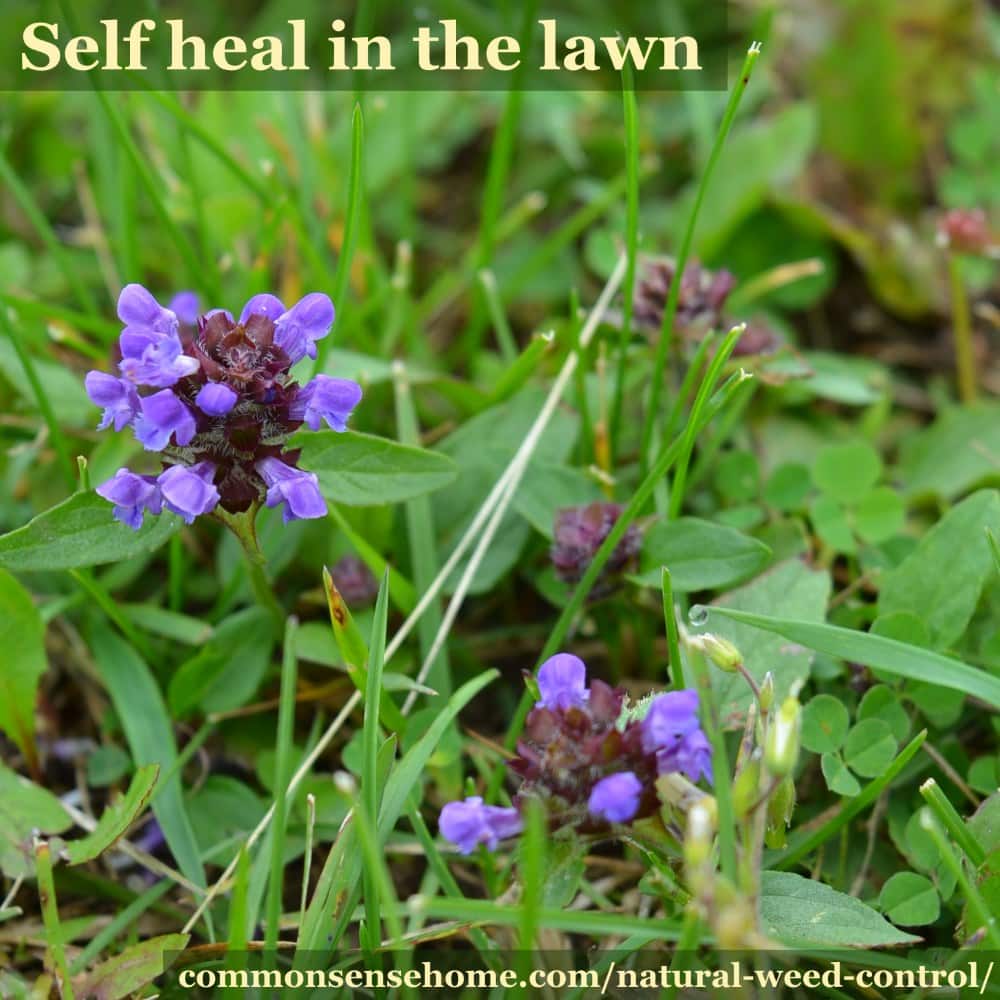
What your favorite way to control weeds without poisons? I’d love to hear from you. Have a particularly problematic weed? Leave a comment and I’ll see if I can help.
As always, Pins, Shares and Comments much appreciated. 🙂

You may also enjoy:
- 5 Reasons Why I Want Weeds in My Garden
- What if I told you weeds and bacteria could save your life?
- Grandma Called it Medicine Leaf
Originally posted in 2015, updated in 2017.

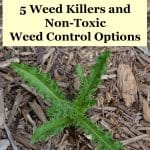
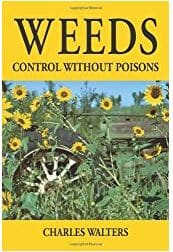
I have lots of moss in my yard, mostly in the shade. Is there anything I can use to get rid of it . I have put lime on the lawn but maybe not enough? Anything else?
There are different moss killers available (some sites recommend iron sulfate or dish soap), but the main trigger of moss is shady, moist conditions. Unless you change the microclimate, the moss is going to want to fill that spot in the ecosystem.
hi, very interesting site btw. My problem is i have bracken gradually invading my garden. I pull a fair proportion of the stalks up each year but they continue to spread into the open grassland. (im away from home alot) They are coming from a ten foot high earth bank that surrounds my garden and is quite difficult to access with cutting equipment there are small trees on the bank too and fruit trees near by. my local farmer cuts the bank once a year when he harvests the grass for hay but the bracken is slowly spreading. Do you think vinegar is my best bet to halt the advance of these invaders or is there some other method that could be more effective? . any advice gratefully received!
I haven’t personally dealt with bracken, but I did some hunting around looking for suggestions. (Nothing in my two favorite weed control books on this one.)
The problem with bracken control lies in dealing with those root runners. It can also spread via spores, so even if you knocked out the runners right next to your garden, you could easily get reinfested from nearby stands.
Vinegar is likely to only knock back the tops, which would weaken the plants but not kill them. From what I’ve read, even twice a year mowing is unlikely to knock them out. Unfortunately, mulch, digging, pulling and other physical controls seem the most effective, although if you can catch the young plants repeatedly with vinegar it may help. Cutting or crushing the new young growth repeatedly, combined with cultivating and planting a different ground cover to crowd out the ferns, is likely to be the most effective.
I’ve just started to increase my mulching and have covered a bed with an inch or so of compost and will keep adding to this as I can but I am seeing a lot more slugs and have to go out at night to remove them.
N.b I am in the uk
Yes, wet weather + mulch can cause a boom in the slug population. I use mostly DE and eggshells, although we’ve just purchased runner ducks to help out this year. You can read more about slug control options here – https://commonsensehome.com/natural-pest-control-in-the-garden/
You suggested calcium and magnesium should be added to the soil to kill Canadian thistle. Where do I get it And do you know the name of some of these products.
Dolomite Lime contains both magnesium and calcium. You can find it on amazon (get 5 pounds of dolomite lime here), or potentially at your local garden center, or online through other garden supply providers.
Hi. I used Homemade Vineger Weed Killer Spray option to kill dandelion. I usually boil the vinegar to create the acetic acid to be concentrated as this will inevitably create a potent killer. Thanks for your sharing. –Ann
How long does it take before it kills the weed week to or days
At the end of the summer into fall I trim back my huge Hostias and take some of the mulch from the flowerbed, cover the area and mark with a stick so I know exactly where witch one is. Last year as I was doing this I noticed a lot of mold on the under mulch I raked. We used the black lined fabric liner before the mulch last yr to try to keep unwanted weeds from coming up. But why so much mold is my question.
Thank you in advance!
( I love to read your pins that you post. They are so interesting! )
Hi Bren1
Mold likes moisture. Black fabric will breath more than plastic, but it is still prone to trap moisture compared to bare earth. The large leaves of the hosta also trap moisture underneath them, and block out the sun – which could help cook out the mold. Hostas also tend to be planted in shaded areas in the first place, so basically you have a near perfect mold and fungus environment.
The mold in and of itself isn’t a problem – unless you have mold sensitivities or it’s creeping into the house. To reduce it, you could replace the landscape with something more breathable like cardboard, and clip back the hostas a bit to improve air circulation. But if you have an area that’s prone to mold, it’ll be tough to eliminate it completely.
Glad you enjoy the pins!
Thanks for the advice. I like what you said about not all weeds needing to be destroyed. It makes sense, even if I’ve never thought about it. Do you have any advice for recognizing those weeds? If I can use them, I’d love to give it a try! I certainly have plenty of weeds around my house.
You can visit the Weekly Weeder series on the Herbs and Wildcrafting page – https://commonsensehome.com/wildcraftingweekly-weeder/ to learn about identifying over 40 common weeds.
What do you recommend for small maple tree weeds growing in shaded mulched areas? I don’t know if vinegar without sunlight will do anything.
Vinegar without sunlight will not be as effective, but it may be enough to damage the leaves, especially if combined with a squirt of dish soap. Clip back, mulch with cardboard to smother and additional mulch, or digging/pulling may work, but tree seedlings can be notoriously tough.
We have different types of grass growing around our A/C unit. It loves the water that drips out. I have used most all of the natural weed control methods as well as the commercial stuff. I can’t get rid of it. Even pull it up. What can I do????
I don’t know what the layout is where your weed problem is, but is there any chance you could apply thick, smothering mulch, and then plant a low growing ground cover that would crowd out the grass and suck up the drips from the AC?
I would appreciate ideas to control bindweed. It is infesting my fruit cage and the beds next to this. I have spent much time digging it out, but as the roots can go down below 1 foot or more it is hard to get to the bottom, and pulling only breaks off sections of root, leaving the rest to grow again later.
Our soil is acid and the climate warm and damp (Cornwall UK)
I’m wondering if you have hedge bindweed (Convulvus sepium) or field bindweed (Convulvus arvensis). My research indicates that both grow in the UK. In either case, “Weeds: Control without Poisons” notes that bindweeds thrive in eroded, low humus soil with low calcium, potassium and pH – which seems a match for the conditions you describe. Work to improve your soil quality, introducing organic matter and calcium. If this is a static planting, you can still top dress the soil with both. Composted manure or compost, agricultural lime or crushed eggshells – these are simply measures you could start with. I’m guessing you may have a service over there like our Extension Offices that offer soil testing with recommendations on how to improve the soil, which would be a good long term approach.
I have high ph soils and saltgrass thrives in it. It will grow clean through my potatoes. Do you know any way to kill it. It grows like quackgrass and will reproduce from a root segment as well as seed. I have added sulphur to lower ph. Not so effective yet yhough. Any ideas would be very helpful. Thanks.
Doing some research online, most things come up with ways to spread it rather than ways to control it, and the ones that talk about control go in the direction of broad scale herbicide.
The USDA website says that it spreads more by the rhizomes than the seeds, and that if the rhizomes dry out it can kill a stand that is trying to get established. Maybe solarizing the soil before planting with garden crops would help? I’m generally not a fan of solarizing, because it disrupts soil bacteria, but it may be necessary for a particularly aggressive weed. Alternatively, heavy mulch and cultivation to remove rhizomes before planting. It likes to be burned, so flame weeding seems like a poor choice.
Do you have anyway to get rid of the dreaded Bermuda grass? It has taken over my asparagus bed and blueberry bushes! EVIL!
“Weeds, Control Without Poisons” notes that it won’t grow in shade (but then, neither will the blueberries or asparagus…). They recommend shallow tilling before the ground freezes for control. I think plenty of mulch, in combination with cleaning out as much of the rhizomes as you can each fall heading into winter, is probably your best bet. I have grass issues in my blueberries and asparagus, too, but the blueberries are doing much better with a heavy layer of wood chip mulch. Now I just need to track down more straw mulch for the asparagus.
Hi. I have a real thisle problem. Any ideas on how to get rid of it. Vinegar solution only gets the tops not root of the problem.
Chantelle – see notes on Frank’s comment.
A rancher friend told of how his dad had the boys take their pocket knives and excise the thistle (preferably rosette stage) down a ways under the ground and put a teaspoon or so of salt down the hole made. Sure kill if you don’t have too many.
davee
Hopefully they didn’t have too many so they didn’t get too much salt in the field.
Great ideas! What about so-called noxious weeds such as canada thistle or wormwood? They are particularly resilient, and canada thistle is terribly annoying. I would love to discover a solution that doesn’t involve chemicals like all my neighbors use.
From “Weeds, Control Without Poisons”:
“Canada thistle likes low calcium levels in its soils, and extremely low manganese… Thistle likes high iron, low calcium, and poor organic matter structure in the soil….
High amounts of nitrogen applied to soils low in calcium leave the soil without a governor, and the results is an excess flushing out of minerals.”
So – too much nitrogen = thistle stimulation.
Not enough calcium and manganese available in soil = thistle friendly. Too much iron = thistle friendly. Poor soil structure = thistle friendly.
A good soil test, which may be available through your local cooperative extension office, is always a good place to start to identify missing nutrients. Additional calcium seems like a reasonable choice, and building up the organic matter in your soil is good for just about everything, not just thistles.
I’m loving your blog. The weed control information is great. I use the vinegar, salt, dishwashing liquid on my weeds. It works well. I used it last year… too near a tree. The tree got saved but it was sick for a few days.
Here in arid New Mexico, it’s almost a shame to kill weeds (they are green at least.) They also have vicious stickers & spread like wild fire if not discouraged.
Thanks for the great gardening tips.
-Smiles-
Glad you’re enjoying the site. Yes, it’s good to note that anything strong enough to kill weeds will likely take out desirable plants, too, so it’s important to be careful.
I’ve seen some interesting projects done with permaculture plantings that effective create an oasis in the dessert with the right combination of plants. Gaia’s Garden: A Guide to Home-Scale Permaculture, 2nd Edition features one of these examples.
features one of these examples.
“planting hills of squash around the edges of the sweet corn patch … deters racoons” This is something to try next time ’round!
I tried the mounds of squash with the corn and the raccoon got to it anyways. I think it is a myth that they don’t walk through squash vines. They are pretty smart.
What do you use for candian thistle. I pull it out but it just comes back every year. Should I pour some vinegar down the hole?
Depending on the coons, I’m sure they can get through just about anything if they decide to, but I have had good results in the past combining the corn and vines in my garden and not getting raided while our next door neighbors had their patch seriously raided.
From “Weeds, Control Without Poisons”:
“Canada thistle likes low calcium levels in its soils, and extremely low manganese… Thistle likes high iron, low calcium, and poor organic matter structure in the soil….
High amounts of nitrogen applied to soils low in calcium leave the soil without a governor, and the results is an excess flushing out of minerals.”
So – too much nitrogen = thistle stimulation.
Not enough calcium and manganese available in soil = thistle friendly. Too much iron = thistle friendly. Poor soil structure = thistle friendly.
A good soil test, which may be available through your local cooperative extension office, is always a good place to start to identify missing nutrients. Additional calcium seems like a reasonable choice, and building up the organic matter in your soil is good for just about everything, not just thistles.
Another tip for increasing the effectiveness of vinegar against weeds is to evaporate it from a 5% solution to a 15% solution. Some garden centers carry it and it must be available on line. I boiled it down myself one year. Will not do that again. It took several hours for my eyes to stop watering. Now I transfer the vinegar to big glass jars and stick them in the sun. It takes a few weeks to get down to a third of your original volume. This doesn’t work well on grass except for the grass in the lines or cracks in concrete. BTW, vinegar is used to clean concrete, just be prepared to clean all of it and not just the weedy spots.
For areas not shared with plants I want, I use a propane torch. It’s loud so birds and other critters scatter before it gets too close, and there is no chemical residue–just dead weeds! Can’t do this after a dry spell, though!
I am having a terrible time getting rid of “creeping Charlie”, which is a strangulating vine weed in my flower beds. Any ideas on how to more aggressive attack that problem to rid my gardens of this invasive weed?
Creeping Charlie is featured in the Weekly Weeder series – https://commonsensehome.com/creeping-charlie/
For control, gathering up creeping charlie using a ground rake is more effective than most methods. It thrives in poor soils, so a soil test is probably a good idea. Compost, aged manure or other fertility boosters are typically a good place to start. I have creeping charlie in my garden, but it doesn’t spread in the huge mats that I remember covering grandma’s yard. It’s quite well behaved, as weeds go. Some people use borax or vinegar for control, but enough of either to kill it will probably hurt your flowers.